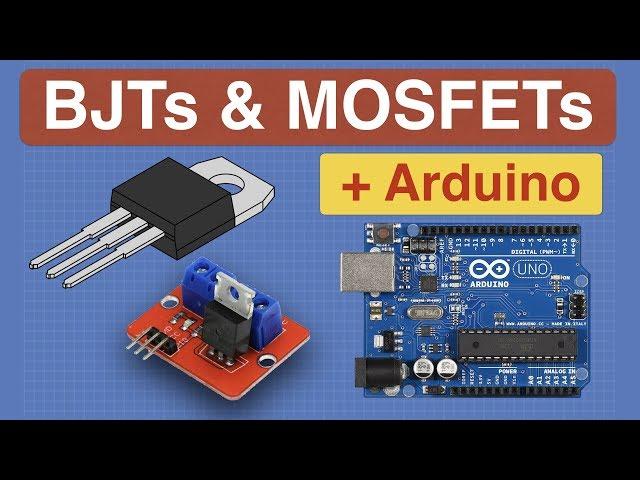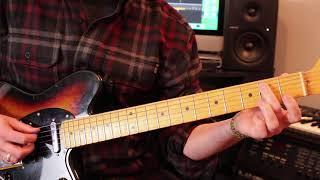
MOSFETs and Transistors with Arduino
Комментарии:

Every DBW video I see, I'm just blown away how well you break stuff down. You're the single reason I'm still doing electronics
Ответить
What is the reason for the 1k resistor between the IRF520 Gate and ground connections? And do you know the reason it is sized at 1kohm?
Ответить
Hello, I need to ask you a technical question about a circuit. You can leave me your email and I will send you the schematic.
Ответить
Love your workshop.
Ответить
Hello. Great video. Question:
How do you calculate the resistor value that you should put in series with a specific transistor in order to prevent it getting overcurrent?

Long life and prosperity
Ответить
As some one wrote on arduino forum: MOSFET with F in its name like the IRF520 shown in the begining of the video doesn't work very well with arduino since they are not LOGIC MOSFET. Is this true? Because i see online there are stores that selling IRF520 MOSFET, and they say it's arduino compatible ( IRF520 data sheet itself only specify Rds(on) at 10v).
Does this apply to BJT? Do i need a logic level BJT to be able to control it with arduino?

Hello, I wanted to ask what's the blue ribbon(is it called that way, my english is not the best) you have around your wrist?
Ответить
Dear, would you please make a video, who to take control for the led strip RGB from a microphone instead of potentiometer, thank you.
Ответить
This guys great. Thanks for the help man.
Ответить
You Sir are one of the few ppl on YT who use esd protection - wrist strap and dissipative foam for lining your parts drawers.
Bravo!

Exciting and well-put video. Thank you, Sir!!
Ответить
One thing you did not show when you did the schematic for the devices is the power conection to the Arduino.
Ответить
Thank you very much. very clear educational tutorial.
Ответить
That's a top level demonstration / tutorial. Thank you.
Ответить
Mosfet's and Transistors are as I am right semiconducters made with silicon, what if we made those of recycled aluminium, glass and Carbon-plastic That is cheaper in fabrication perhaps and faster in transmission. Thank you for this video
Ответить
Thanks a lot for all this work, which becomes a "must watch" for all makers.
Ответить
I am very grateful for the explanations and suggestions, the truth is that he takes knowledge to the highest level very seriously, thank you very much. Please do not stop with this brilliant way of approaching electronics.
Ответить
Thanks for sharing your knowledge!!!
Ответить
Didn't know Mr garrison was a technician
Ответить
You should always use a gate resistor, since capacity of the gate of a MOSFET causes a high current when switching on, which could destroy the I/O pin of the arduino.
Ответить
Atmega AVR has already Pullup-Resistors on-die, that can be enabled by pinMode(INPUT_PULLUP) or the like... in earlier libraries, it was INPUT and then digitalWrite(input_in, HIGH) that enabled the pullup.
Ответить
Electronic is amazing but supernaturally complicated 🥺
Ответить
Oh my god that's a large battery. I was thinking in the scale of 9V battery. Like an Energizer. 😅
Ответить
Great Learning, Sir. Thank you so much. I have a question : How can I determine the current limiting resistor value for the transistor and MOSFET?
Ответить
Fantastic! Thanks a lot for all your great, inspiring work & tutorials.
Ответить
Hello The videos in this channel are a great learning tool, easy to undestand.
I need to know if an IRF520N module is suitable for up-volt a serial 9600 tx signal
(up volt to 12Volts, required for Arduino automotive scanning tool project)
If not any better options?

Thanks for the channel. Could you explain why IC's are so fast?
Ответить
Sir you awsome 👍👍👍👍
Ответить
Can we use arduino to switch (MOSFET) 5 A and 30 V power supply? Because I ended up ruin the arduino.
Ответить
do you need a flyback diode for the mosfet module?
Ответить
Super video. Many thanks. I have an issue though. I'm using a single MOSFET connected to the output of a DAC connected to a UNO. I have set up a sketch that generates a sine wave at the output of the DAC. When I view this on an a scope it a perfect analogue sine wave. When I connect this to the drain of the MOSFET the output of the MOSFET is no longer a sine wave. The output voltage of the MOSFET does not reflect the sine wave. It switches on and off as the voltage increases and decreases but is nothing like a reflection of the input voltage. Should I be seeing a sine wave or is the relationship of signal voltage input to output voltage more complicated? Many thanks again.
Ответить
Thank you very much for your knowledge, my professor.
Ответить
I love your workshop. It is clean and organize. And I enjoy your three projects specially last one. I request you pls when writing arduino sketch on board use large font to see us clearly. Your font to see so small to look here. And lastly, would you share two more exampls to use Mosfet in real life. And when using mosfet I notice you can not reverse the motor direction. If we want both reverse and forward direction than what we will do? Thanks for everything and making us your kind video to learn.
Ответить
Very much appreciate your video as it educated me on the difference between transistors and MOSFET's. I've built a circuit similar to one you built to control LED strip using 3 MOSFET's (I used IRBL8721 with 1K resistor). My problem is the individual RGB LED do not seem to be going on/off based on my Arduino code. When I attempt to turn one on (i.e. Red) the Green and Blue LED's are still on though at somewhat lower intensity. Any idea what could be wrong with my circuit?
Ответить
wow you really know how to explain things thanks a lot
Ответить
Amazing video, sir!
Ответить
Saw this last weekend. Helpful video
Ответить
An excellent introductory tour - and for those of us doing mainly digital electronics you cover most of what we need to know about interfacing our puny logic circuits to the power hungry big-boys world of motors, relays, solenoids and lamps.
One quick observation. As you noted, the LEDs on an RGB chain get quite hot. Thus, it's NOT a good idea to operate them on the reel like that for very long as they can get heat damaged and you start to get failures. Each individual LED doesn't generate much heat, but on a reel like that each position contains three LEDs (a red a green and a blue) and over a 5M length you may have a couple of hundred of them. When theyy are spread out its not really noticeable, but when they are reeled up tight together like that they generate quite a lot and if used for long they might overheat and fail.

On the wiring diagram you connected the diod parallel to the motor inputs - isn't there a mistake? How can it protect from backward current from the motor spinning up floating back to transistor, when it's connected that way? It should be connected sequentially instead, no? On the real schema you connected it correctly I think
Ответить
You need more bins.
Ответить
Hy, i have a question, can you tell me how can i connect a loudspeaker digital volume control to a hall sensor (from finger throttle's ebike ) in order to be able to control volume. Thank you in advance for your answer
Ответить
That was awesome thanks much
Ответить

























